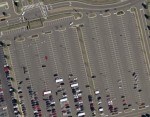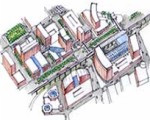|

Ideal transit station surroundings, according to the MTA |
Supporters of the Corridor Cities Transitway, a proposed BRT or light rail line running north from Shady Grove Metro through Gaithersburg and ending in Clarksburg, say the project enjoys such widespread support that the lack of controversy has kept it out of the sight and mind of Maryland officials, whose time and money is taken up by more contentious projects such as the ICC and Purple Line. State Del. Jean B. Cryor goes so far as to say that she once suggested supporters “hire some people who opposed us to create some controversy”.
You want a Corridor Cities Controversy? BeyondDC has got one for you: Bad planning. Considering the mess that is planning in Clarksburg, we’re surprised locals haven’t thought of this on their own, but the fact of the matter is the Corridor Cities Transitway is such a horribly planned line that it leads one to wonder if those in charge of its planning have slept through all the lessons learned about transit over the past generation.
Even if one accepts that the best place to spend transit dollars is in relatively new suburban areas, some of which can still be called nearly rural, the decision-making behind proposed Transitway station locations is downright obsolete. Every transit planner in the country worth his paycheck knows that the most successful transit systems are those that are focused around urban, pedestrian friendly nodes, of which upper Montgomery County – one of New Urbanism’s hottest beds – has several. Correctly planned, the Transitway would be a string of pearls connecting some of the finest suburban attempts at city-building in America.
But what’s the reality? The planned route bypasses the walkable part of the Washingtonian Center completely, skirts the edge of Crown Farm, bypasses Kentlands and Lakelands, and ends just short of Clarksburg Town Center. The route does, however, make several laboriously slow stops at office campus locations surrounded by nothing but parking lots that no one will ever walk to or from.
What could possibly be the thought process behind this seemingly backwards planning that ignores mixed-use, dense, transit-friendly destinations in order to serve office parks that only a handful of commuters might use and which are easy to drive to anyway?
I’ll let Rick J. Kiegel, a consultant assisting the Maryland Transit Administration in managing the project, explain: “We looked at transit centers that could provide large scale parking”.
Whether they don’t know, have forgotten, or simply don’t care, Transitway decision makers want to build a line that ignores every lesson from the past generation about what makes transit successful. In other words, they want to build a transit system doomed to failure (scroll down, see entry titled “Train in Vain”).
If that’s not controversy, we don’t know what is.
Average Rating: 4.9 out of 5 based on 248 user reviews.
September 27th, 2006 | Permalink
Tags: government, transportation

|

BeyondDC in Chicago? |
We take a lot of pictures here at BeyondDC. Most of them are of subjects in the immediate Washington metropolitan area, but every so often we venture out into the wider world and do some exploring. So, despite the fact that this is a website about Washington, DC, we figure why not share what we’ve got? Check out our new feature, Way BeyondDC, for photo galleries of cities that have nothing to do with Washington, from New York to tiny La Junta, Colorado.
Note: We’ve shuffled the main menu a bit. The newsfeed is now a top-level item, while all galleries, including regular photos sets and “Way BeyondDC” sets, are now accessible via the “Features” submenu. |
Average Rating: 4.6 out of 5 based on 272 user reviews.
September 22nd, 2006 | Permalink
Tags: galleries

|

The Rochambeau |
The Catholic Archdiocese of Baltimore yesterday won final permission from the Maryland Court of Appeals to destroy and replace with a garden the Rochambeau apartment building, one of the most grand historic structures in Baltimore’s most grand of historic neighborhoods, Mount Vernon.
Apparently the Archdiocese didn’t get the memo explaining that the era of tearing down magnificent historic landmarks ended a 30 years ago. Preservationists did what they could; the Church simply doesn’t care.
See it while you can.
Original photo by Chiaki Kawajiri of the Baltimore Sun, altered for use on BeyondDC. |
Average Rating: 4.6 out of 5 based on 213 user reviews.
September 13th, 2006 | Permalink
Tags: preservation

| Loudoun County has once again adopted growth restrictions for the western, rural portion of the county. By 5-4 vote, supervisors adopted new zoning that requires 20-acre lots in the northern part of the county and 40-acre lots in the south, leaving alone the eastern, more developed portion. The idea is to control sprawl and preserve what’s left of Loudoun’s rural heritage.
The new law will do a passable job of preserving Loudoun’s open vistas. It will, on the other hand, be a disaster for regional sprawl control and any other nearby localities hoping to preserve their own rural character.
Why a disaster? It’s pretty simple, really. Growth doesn’t go away if you fail to accommodate it; it merely moves to the next easiest spot. By slowing the development pipeline in Loudoun, officials there will directly cause it to speed up elsewhere. If a metropolitan area has effective regional incentives that make it easier for that growth to be accommodated closer-in rather than farther-out, exclusionary restrictions in places like Loudoun can be an valuable tool. Unfortunately, folks in Fairfax being even more wary of growth than those in Loudoun, effective regional incentives to push growth in rather than out don’t exist, so Loudoun’s new laws are more likely to speed up the development leap-frog in places even more remote like Fauquier County and Charlestown, West Virginia.
And unfortunately, the more spread-out we get, the worse will become regional traffic congestion and air pollution, and the fewer open vistas will be around for us all to appreciate.
So thanks, Loudoun. Thanks for shouting at the top of your lungs “I’ve got mine, screw the rest of you!”
Thanks for nothing.
Average Rating: 4.4 out of 5 based on 279 user reviews.
September 7th, 2006 | Permalink
Tags: development, government

|

Proposed TOD at the Route 7 station in Tysons Corner |
No, BeyondDC has not gone suddenly libertarian. We have to ask, however, because in killing the Tysons Corner subway, the federal government has reached a new low in bureaucratic absurdity. It goes like this: The federal government, in determining which transit projects to fund, has a complicated series of formulas involving project cost and projected ridership that ultimately result in a “go/no-go” grant recommendation. Metro being a whole helluva lot more expensive than light rail, the original elevated line through Tysons Corner just barely met “go” standards. The proposal to tunnel through Tysons raised the cost of the project just enough to push it over into the “no-go” category.
Here’s the bit that’s absurd: The federal government wasn’t asked to cover a single dime of the increased cost. Locals in the Tysons area were going to pay for it themselves. If the federal standards were sophisticated enough to take local funding mechanisms into account, the number crunchers would have realized that for the exact same cost to the government, they would get a better project with higher ridership; that is, a more efficient transit line, not a less efficient one.
But the federal government, it seems, doesn’t think. It merely plugs numbers into predetermined formulas without activating a single brain cell in the process. What a shame.
Average Rating: 4.8 out of 5 based on 283 user reviews.
September 7th, 2006 | Permalink
Tags: government, transportation

|
Media





Site
About BeyondDC
Archive 2003-06
Contact
Category Tags:
Partners
|
| |



















